
Condor Premium Economy on Their Flagship A330neo
Less premium, more economy. Think of it more as sitting in an emergency exit row on a legacy carrier: that's about the level of comfort and service you'll get.
Introduction
Condor, a German leisure carrier with a reputation for destinations off the beaten tourist track, can be a very budget-friendly option in the right circumstances. One-way and last-minute flights are often extortionately priced by major carriers, but with Condor you can find one-way flights costing half of a roundtrip, and last-minute fares only marginally more than booking months ahead.
So, for a one-way trip back from Europe booked a few weeks in advance, they were by far the cheapest option, with their premium economy being less than regular economy on all other carriers (LCCs included once you tack on bag fees).
My expectations weren’t high going in considering the price, and…well, that was pretty much spot on.
Transfer Experience
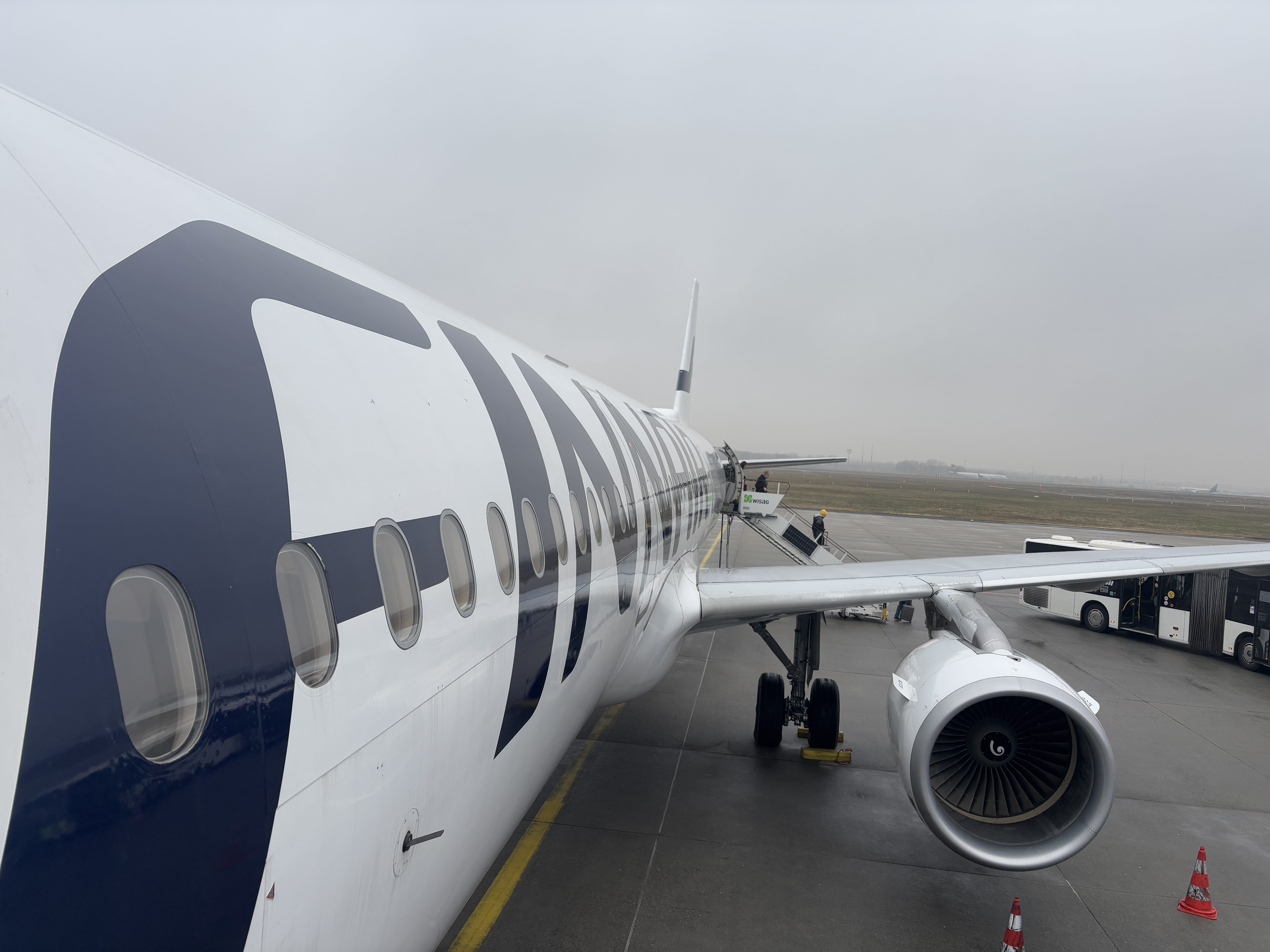
Despite not being part of an airline alliance, Condor has an impressive number of partners feeding into its long-haul routes.
Condor is not part of any airline alliance, but they have an impressively wide array of partners including Finnair. I started this trip in Helsinki, which meant an uneventful two-hour flight to Frankfurt. Note that bookings with Condor in business or premium economy class do not extend to feeder flights: you’ll be in regular economy on flights operated by partner airlines, though your Condor baggage allowance applies for the full trip.
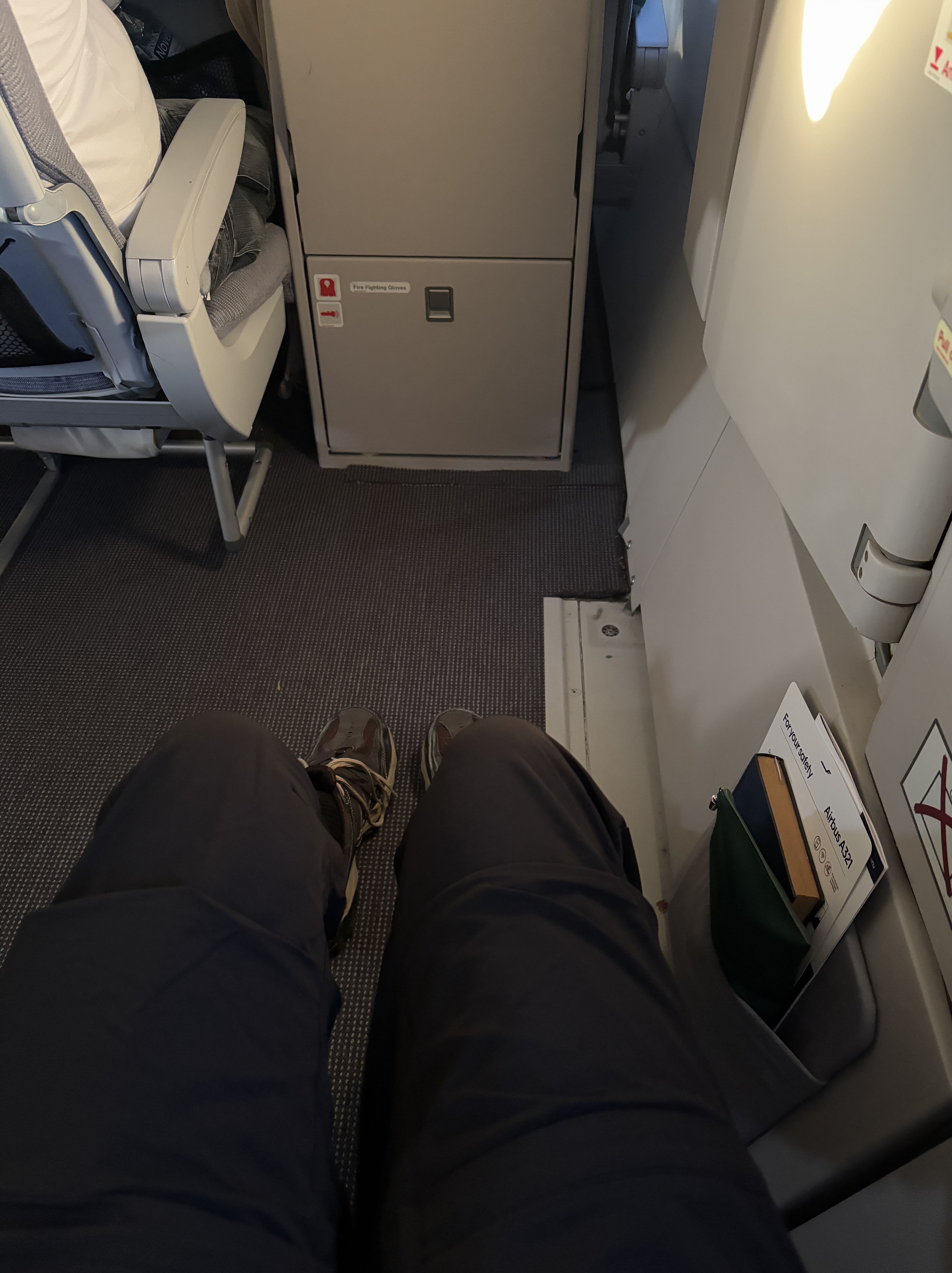
I was more comfortable, with substantially more legroom, in an exit row on Finnair flying from HEL to FRA.
With an early arrival in FRA I had over two and a half hours to make my connection, which at any well-designed, efficient, rationally-run airport would be plenty of time. Frankfurt is none of these things. Poor signage, winding corridors, and miserable staff greeted me, a stark contrast from Helsinki’s excellent airport. After about 20 minutes I made it from the Schengen to non-Schengen terminal, and Googled my gate since FRA is so unjustifiably confident in its efficiency that gates are only displayed on screens for flights leaving in the next few hours.
My Condor flight would be using the B-gates, which meant heading into dark and grey underground hallways to a security check where staff did their level best to keep the line moving as slowly as possible. After about 25 minutes I was through, and ten minutes’ more walking led me to passport control.
To maintain its general demeanour of misery, this is also in an enclosed space with no natural light or features of any kind. To stimulate passengers Frankfurt Airport encourages you to form your own queues wherever you please, with staff only jumping in to yell at passengers when some of them dare ask politely to head to the front, being in danger of missing their flight.
After 35 minutes I made it to the front of the many “lines”. With no words exchanged my passport was stamped and I was through this entirely meaningless procedure that other, better airports have automated.

I got the first view of our plane some 90 minutes before actually reaching the gate.
I found myself at the gate area just under 30 minutes before boarding was due to begin, having wasted two hours of my life as a sacrifice to the myth of German efficiency.
Condor advertises priority security for its premium economy passengers, and my boarding pass had a bright blue “Priority” marking, which was useless: at no point of the transfer process were there separate queues for priority passengers. Or the boarding process for that matter.
Check-In and Upgrades
For a lower-cost leisure carrier, Condor is betting heavily on filling premium seats: its flagship A330s operate 30 lie-flat business class seats and 64 premium economy seats, taking up over half of the cabin space on these planes (the rest going to 216 economy seats). This may well pay off for them, with industry trends pointing to leisure passengers willing to pay more for extra space and amenities. I suspect it did not on this flight though.
Online check-in opens 24 hours before departure. If you have a connecting flight, you’ll have to check in separately with the partner airline. Condor charges for seat selection in premium economy, but since most of this cabin is over the wings anyway I wasn’t bothered to pay extra for a window seat. Seat selection at check-in would have cost €17.99, less than the €29.99 when booking.
Charging premium passengers for seat selection is a trend I dislike (it’s why I’ve only flown BA in business class once), but Condor seems almost spiteful of passengers who choose not to pay extra for something that most carriers include. Despite there being multiple fully empty rows, many passengers (myself included) found ourselves with a seatmate upon boarding. We sorted this out ourselves, and I moved over to an empty pair of seats on the left side, but it created unnecessary confusion as cabin crew worked down the cabin and found many occupied seats that showed empty on their tablets. This is a necessary process as one self-upgrader was sternly sent to his rightful seat by a no-nonsense flight attendant, and could have been much quicker had several passengers not needed to move to maximise space in the half-empty cabin.
When checking in I was offered a business class upgrade for €349, which isn’t bad value at all: with the fare already paid, that would have made around €870 for a one-way business class ticket across the Atlantic. Since this was a daytime flight and I had had pleasant experiences on longer day flights in premium economy before I passed on the upgrade, but in hindsight I should have accepted this offer.
Charging for seat selection in premium cabins is bad enough—grouping premium passengers who don't pay together to leave entire rows empty is just spiteful.
Condor also auctions off seats using a third party app, and I had an email waiting for me on arrival into Frankfurt inviting me to bid. I downloaded the app and saw the auction already at €295 for business class—interestingly I was also offered an upgrade to premium economy for €75, which was the difference between economy and premium when I booked. Not sure what would have happened had I paid to upgrade my premium seat to a premium seat…
At the gate, business class upgrades were still available for €349.
Boarding and First Impressions
Boarding started about five minutes later than scheduled, and was a free-for-all. Boarding groups were displayed on screens and called out, but not enforced whatsoever. For some reason a single staff member was manually checking everyone’s ticket (except the boarding group apparently) and ID, before sending them to the half-dozen automated barriers. Multiple passengers were arbitrarily sent to “special services” as he called it, though I saw some just ignore this and continue onto the plane. It was a mess.
After running the gauntlet of impatient passengers and incompetent staff, two jetbridges awaited: one for business class, one for premium and regular economy. I made my way down the latter, and was greeted by a smartly decorated cabin.
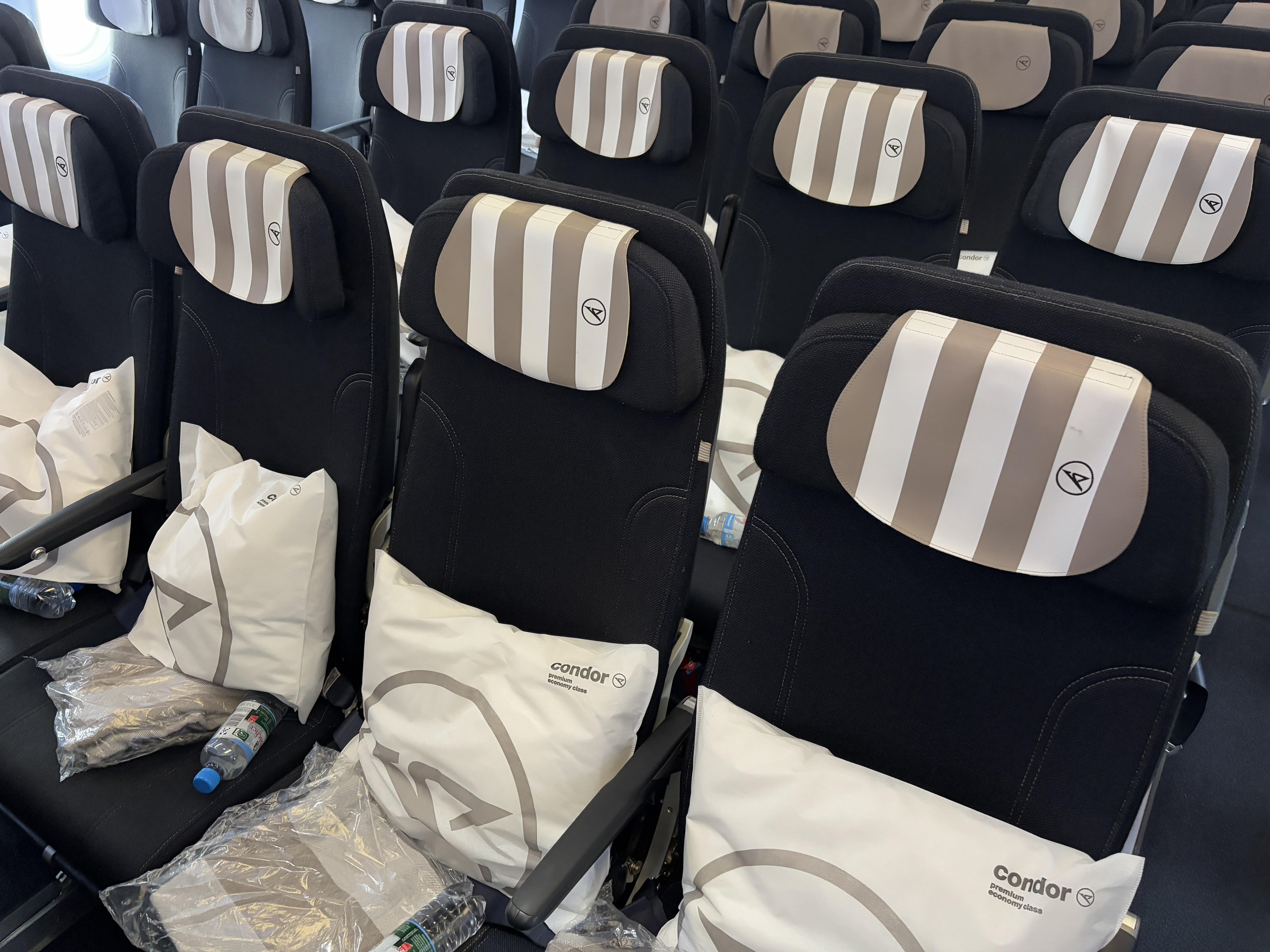
Seats in Condor economy and premium economy share the same width in a 2-4-2 layout.
Condor arranges its premium and regular economy in a 2-4-2 layout. Seats are identical, with premium seats having five inches of extra pitch as well as headrests with a beige stripe pattern, matching the plane’s livery.
Condor has leaned hard into its beach towel rebrand, and I honestly loved it. There were little touches all throughout the cabin matching the loudly-painted plane: the small divider between economy and premium economy, tags on the side of each seat, even a little decal stuck to the tray table fastener was matching. Since beige is the tamest of Condor’s striped colour scheme I’m not sure if the mood lighting also changes to match each plane, but it was indeed colour coordinated for boarding and during meal services on our beige bird.

Small touches matching the plane's livery, like this tray table fastener, appear throughout the cabin.
Waiting at each premium economy seat was a large pillow, blanket, and half-litre of water. As I mentioned above I was automatically assigned a seat in a full four-seat middle section, but after boarding was complete two of us moved into empty rows. One passenger slept across an empty four-seat section for most of the flight. Passengers aren’t just going to squeeze into middle seats for an eight-hour trans-Atlantic flight when there are fully empty rows in sight, and I don’t know why Condor creates confusion by filling up rows rather than spreading passengers out.
Departure
We pushed back about 20 minutes late, but made all of this up in the air. After boarding was complete crew came through the cabin to distribute small menus specific to premium economy, as well as a packaged bag of pretzels.
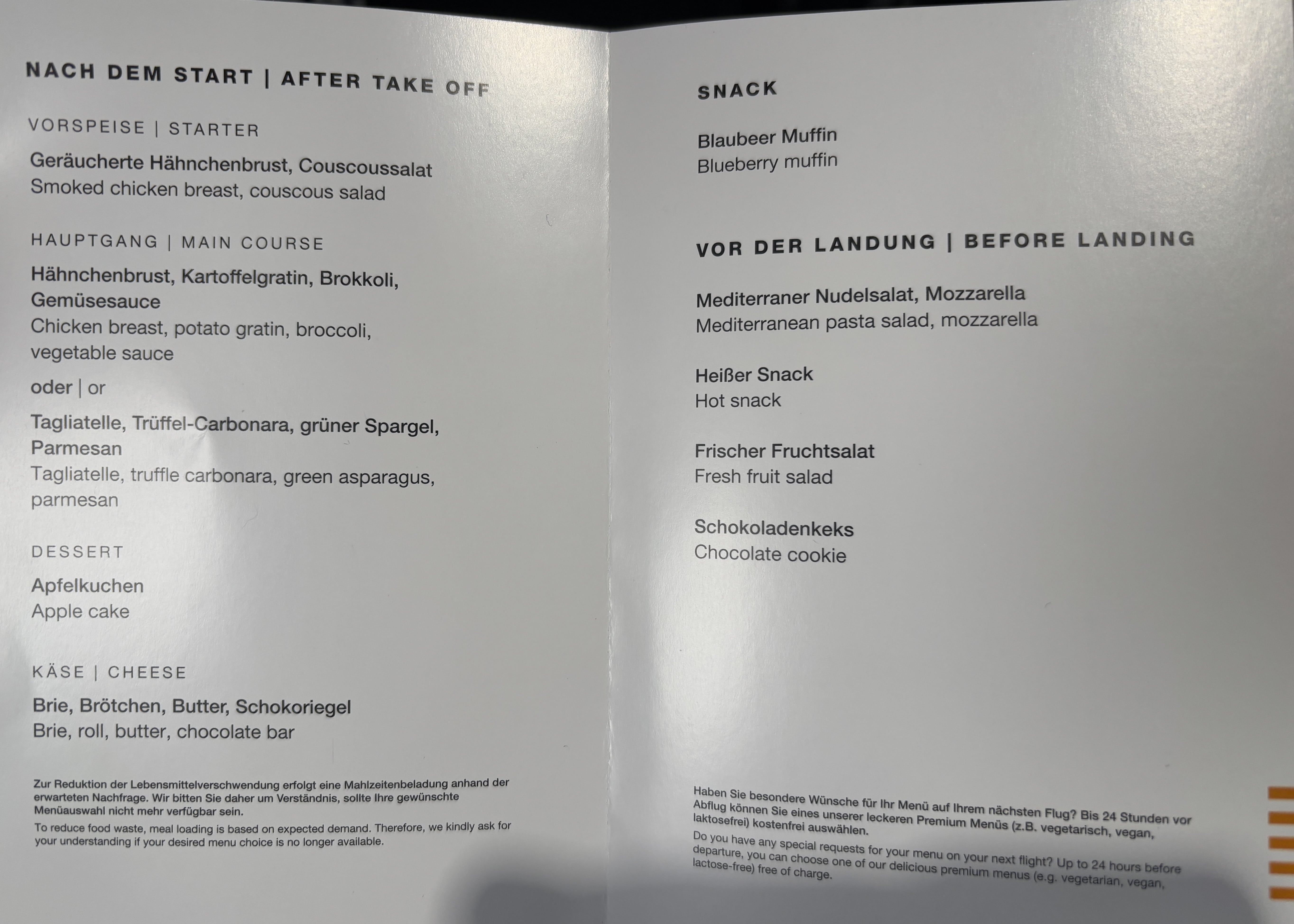
Despite having a separate printed menu, premium economy food service featured only one actual choice: chicken or pasta.
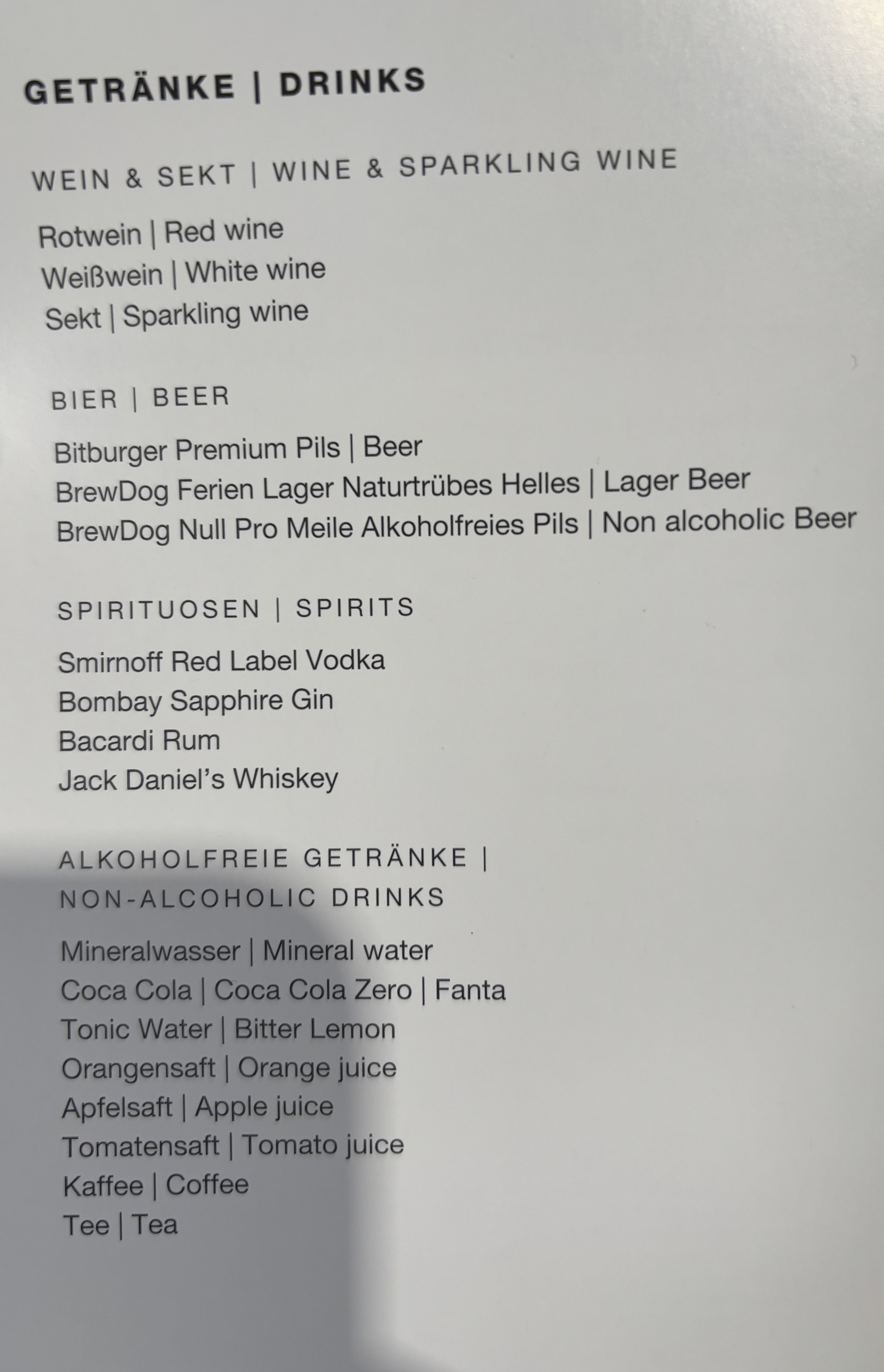
Anytime the wine choices are "red" and "white", you're in for a gourmet experience.
The captain announced we would have a delay of “approximately eight minutes” before takeoff due to heavy traffic, and we ended up airborne pretty much exactly as he forecast.
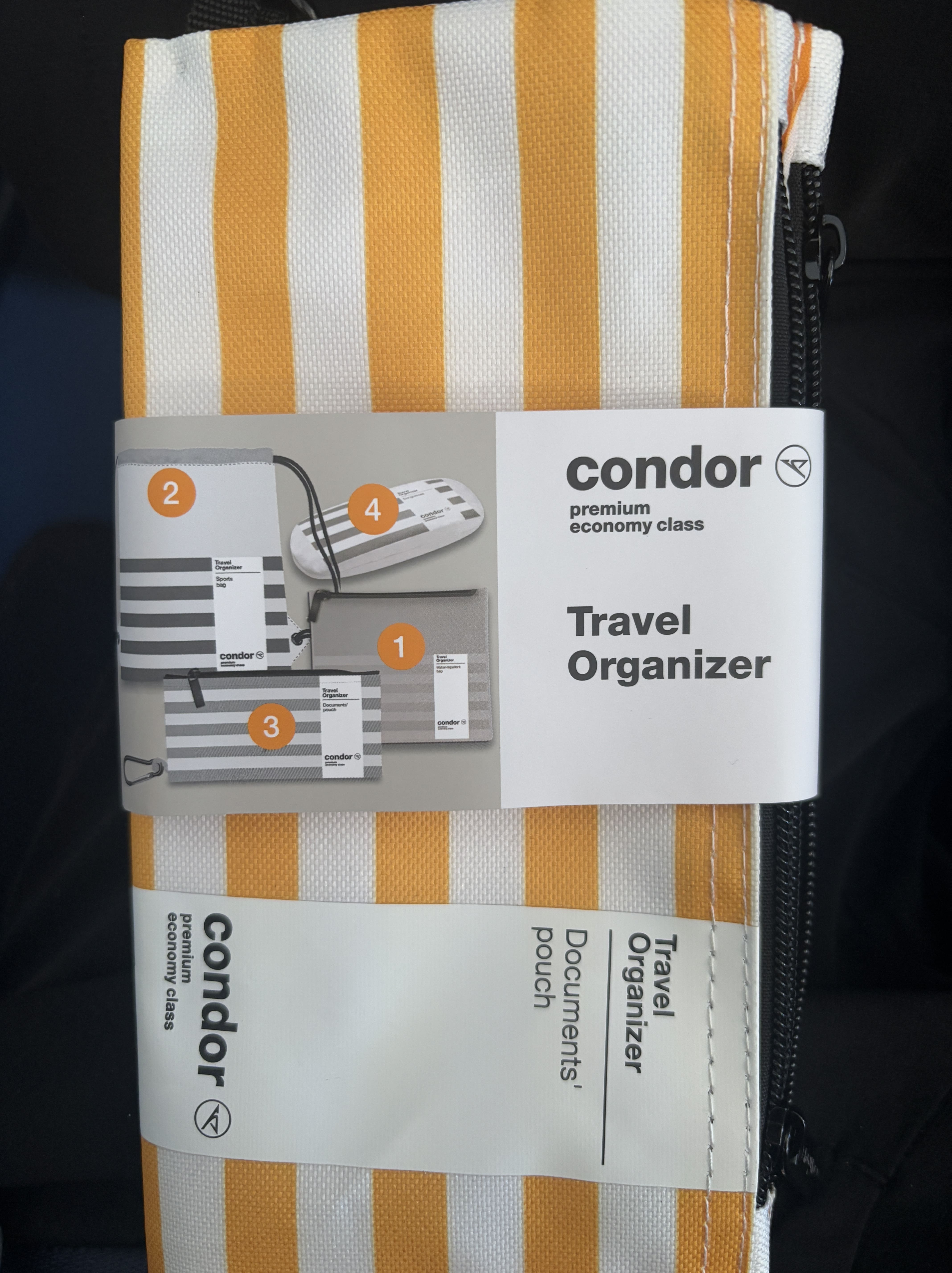
Condor gets around providing actual amenities in its amenity kits by labelling them "Travel Organizers". It's still cheap.
Service started about ten minutes later with amenity kits distributed. Well, more just “kits”, since there were no amenities inside. After this crew came through once again to offer headphones for the IFE system; I opted instead to use my own, but this is a small difference between economy where headphones are charged at €4.
Fifteen minutes after takeoff premium economy passengers were offered what would usually be the pre-departure choice of orange juice or sparkling wine. Since we were already airborne this was an odd service choice by Condor: just run the trolley down the aisle and offer a full bar service. Drinks were served in plastic cups, as would be the case for the entire flight.
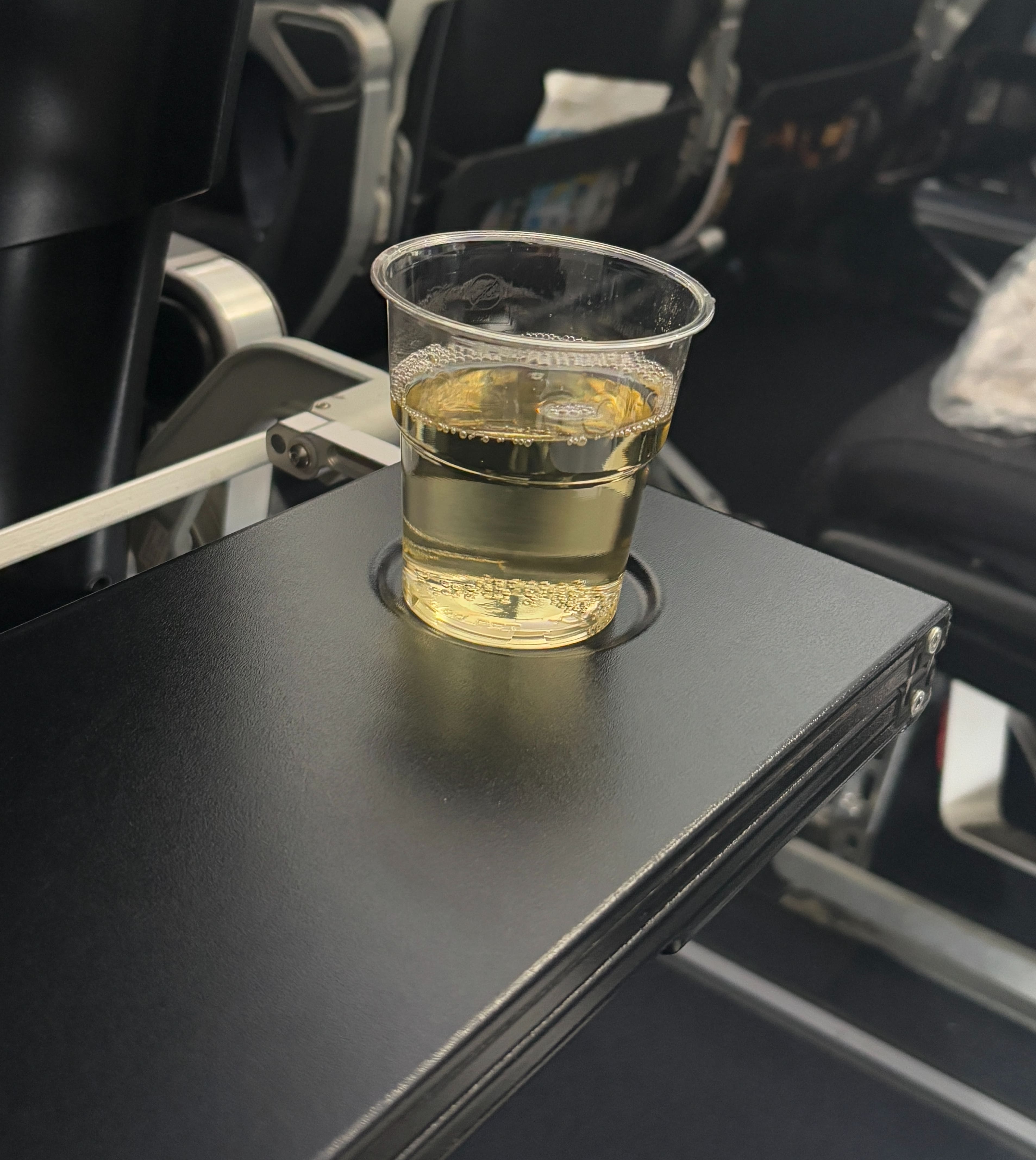
All drinks came in plastic cups, reinforcing the economy feel.
Seat and In-Flight Entertainment (IFE)
Condor economy and premium economy seats are nearly identical, with the biggest difference being an extra five inches of legroom. I actually found this to be less than advertised though: the footrests that come with premium economy seats, though many were missing, intrude significantly into leg space whether the footrest is raised or lowered. It was a nice perk not present on economy seats for the first half of the flight, but in the latter half I would have preferred it not be there so I could stretch my legs more easily.
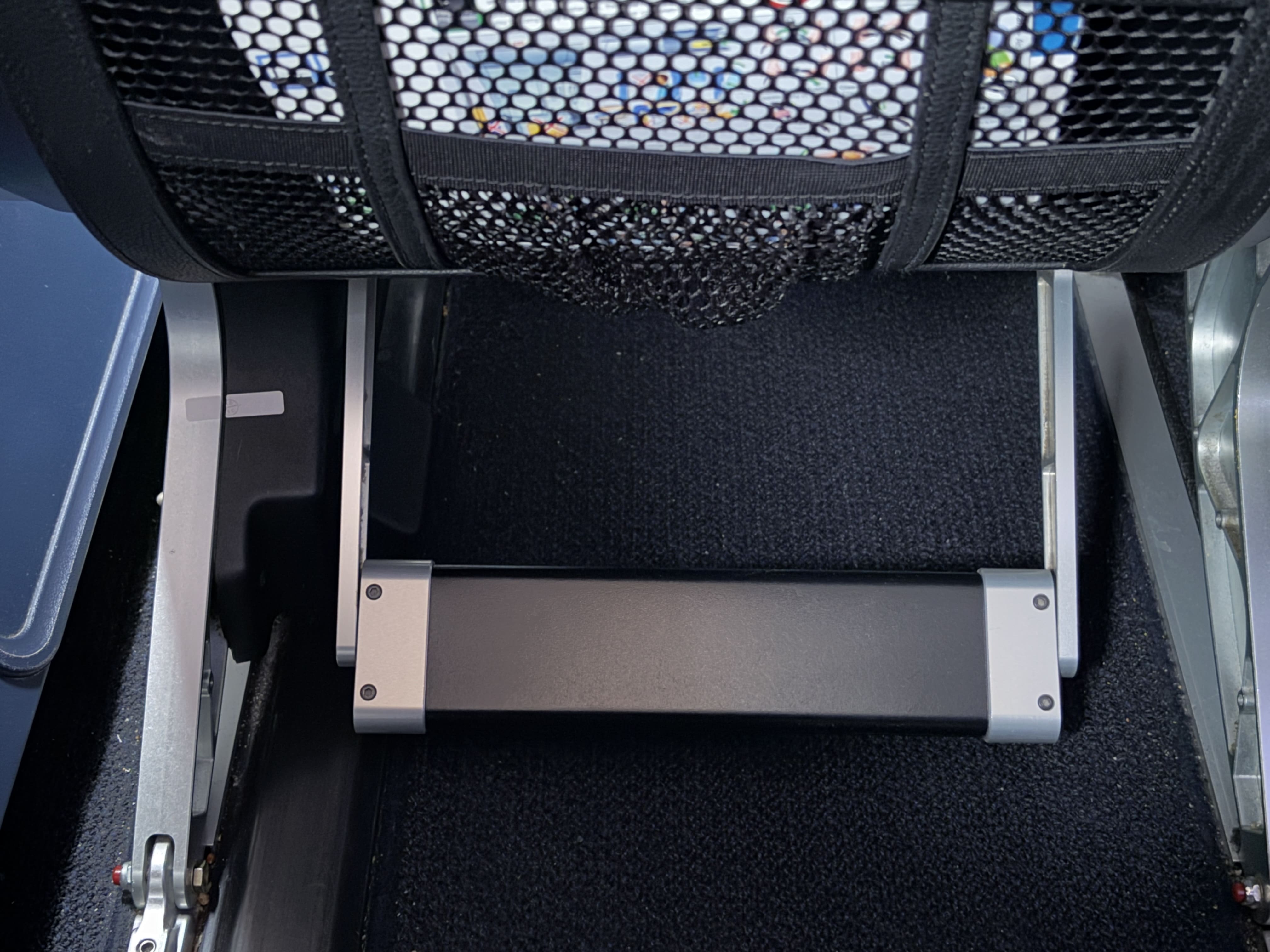
The footrests, missing from many premium economy seats, eventually just got in the way of sitting comfortably.
Economy and premium seats both have coat hooks, a fold-out device holder immediately under the IFE screen, an average tray table that folds out either halfway or fully, adjustable headrest, and USB-A/C charging integrated into the IFE screen. Condor cheaped out and did not install individual air vents, though each seat has an overhead reading light.
Storage was what you expect on long-haul economy, with a stretchable seatback pocket large enough to hold most things you might need during a flight; I had no problem fitting a water bottle, book, and SQ amenity kit in the pocket of the empty seat next to me. Passengers could find any of the following in their seat pockets upon boarding: airsickness bag, in-flight shopping menu, instructions on connecting to the in-flight WiFi, and trash from previous passengers. All seats had the required safety card, though everything else varied by seat and were in universally poor condition; the shopping magazine, present at my seat but not the adjacent one, had missing and torn pages.

WiFi prices were reasonable, but the state of the info sheet reflected a lack of attention to cabin cleanliness.
Seats in premium economy recline to 12 degrees, 3.5 more than regular economy.
I found the seat comfortable enough for the first four hours, bearable for the two hours after that, and just as bad as a normal economy seat (which it is) for the final two hours. The padding was thin, and the poorly-placed footrest left me with sore knees for hours after disembarking; in hindsight I should have moved to one of the many seats where this “feature” was missing.
The in-flight entertainment screen was large and crisp, with adjustable brightness that helped control glare. It could be tilted up or down to match the recline of your seat or the person in front. WiFi was available and reasonably priced: €7 for full-flight messaging access, €20 for full-flight browsing. No streaming was available. I neither needed nor wanted to have internet access so didn’t buy either package.
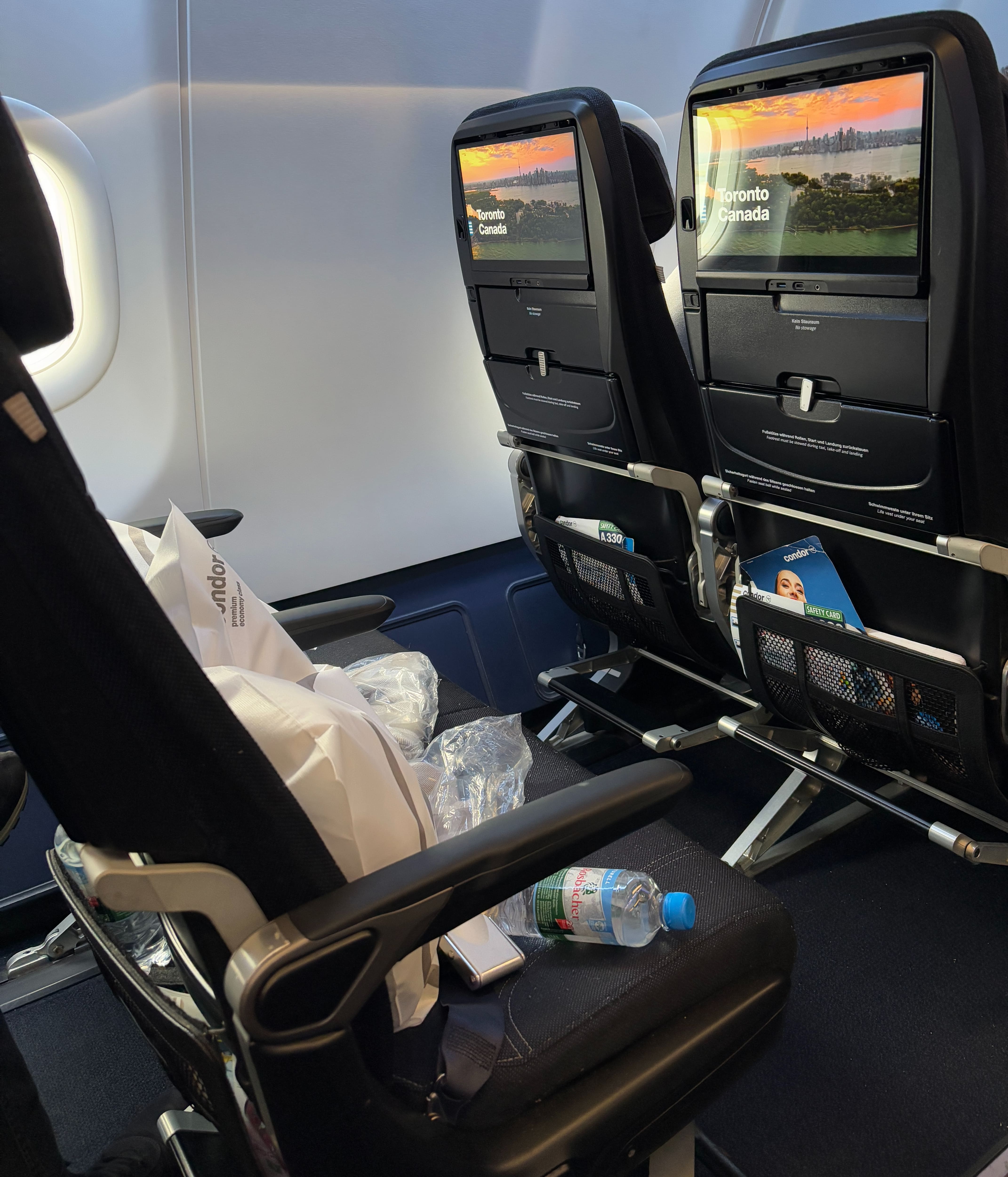
The large IFE screens fill much of your view whilst seated.
IFE options were appropriate for the routes Condor operates, and I had no problem finding things to watch for the full flight. While there were no tail cameras, the IFE screen did have a few neat choices including landing videos for Condor destinations, behind-the-scenes documentaries about Condor operations, and previous matches from the German Bundesliga. Some other options I tried to check out didn’t work: a section about the new Condor A330neos did nothing when pressed, and an “Onboard Upgrade” option redirected to the in-flight economy menu.
The flight map was crisp, and I appreciated the pop-up links to Wikipedia articles about settlements and landmarks we were passing on the ground.

The moving map featured snippets of information about cities and geographical features along our flight path.
Bluetooth connectivity was available and I had no problem pairing my wireless headphones.
For a German airline, the censorship of in-flight content was over the top: swear words I won’t mention here (but yes, the ones you’re thinking of) that are pretty regularly used in casual, if not polite conversation were bleeped out, which made for a solid 15-seconds of silence during one particular scene in Austin Powers that was apparently deemed too sensitive for passengers willingly watching a film about a sex-crazed secret agent chasing a villain with golden genitalia. Glad somebody was thinking of the children.
Meals and Service
The first meal was served about an hour after takeoff. I went for the pasta, which was served on a tray featuring an advertisement for duty-free shopping. Classy.
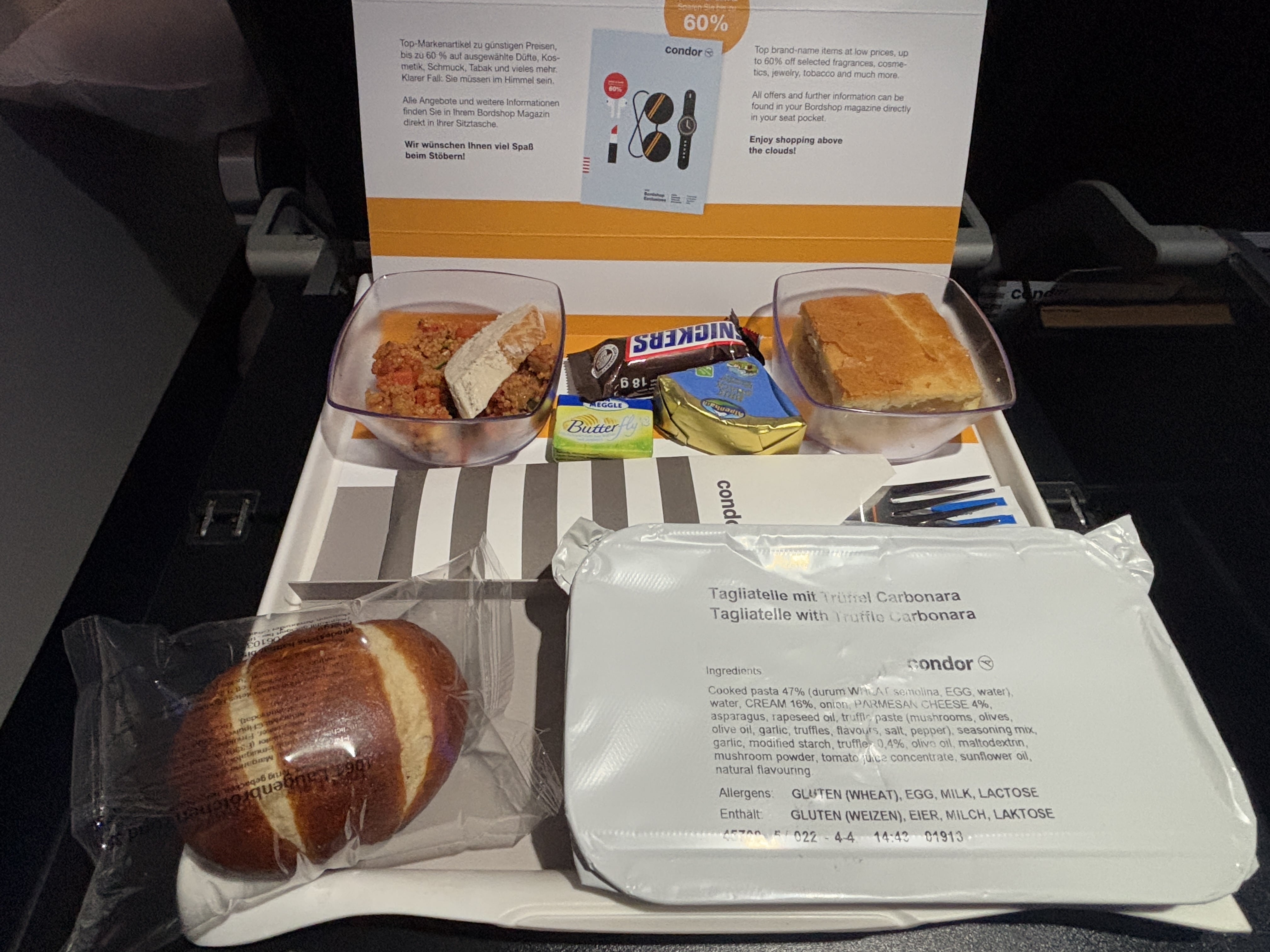
The disposable packaging and tacky advertisement gave a decidedly non-premium feel...
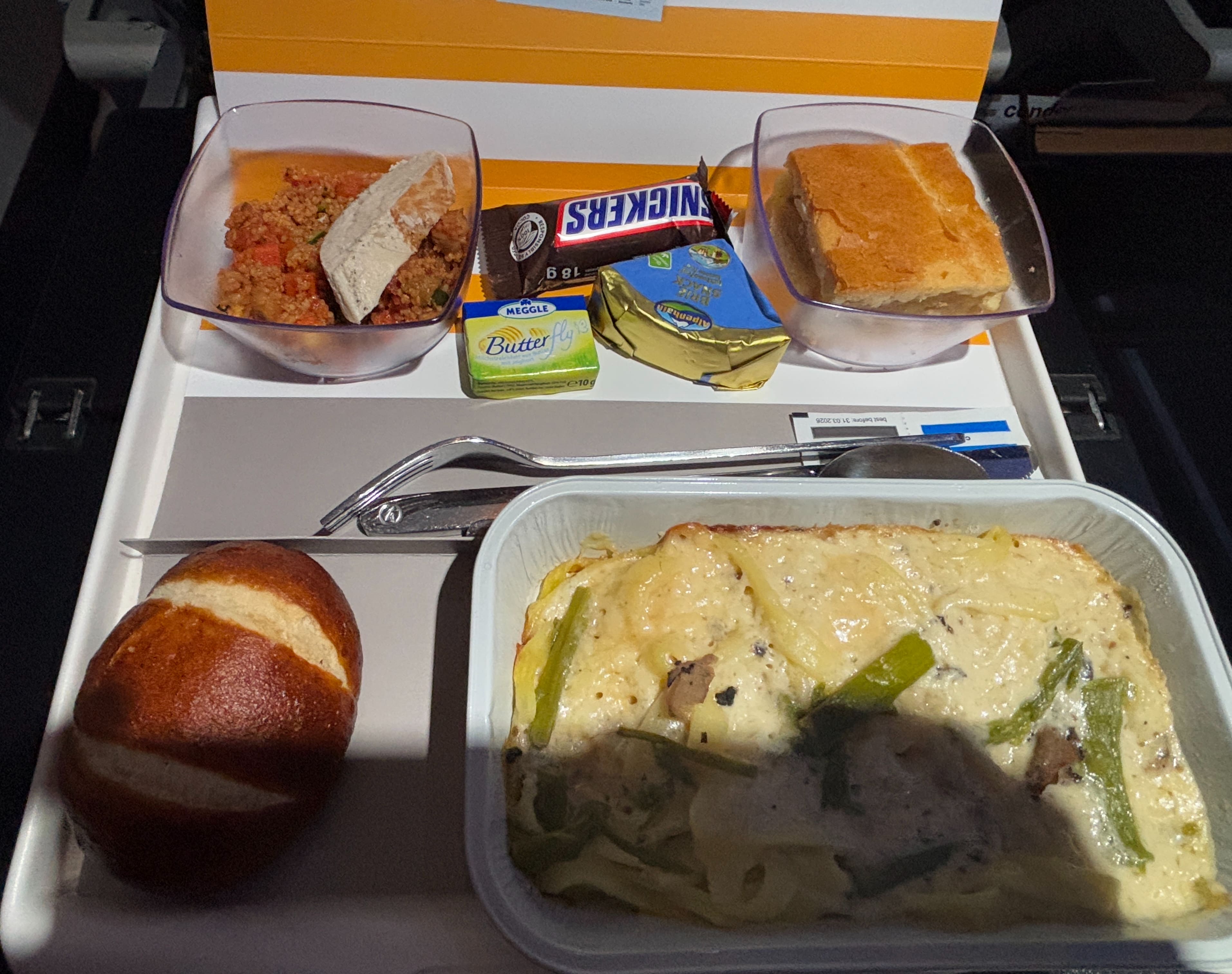
...and the taste didn't help.
The food on this flight was not very good, and although Condor advertises premium dining as a distinction from regular economy nothing I was served would be out of place in the economy cabin of an average airline; the food was actually worse than what I have been served before in Air France economy. Three hours after the first meal service a blueberry muffin was served.
Between these two services I pressed the call button, which was ignored (as it was in both premium and regular economy throughout the flight). A passing crew member did spot the illuminated crew call about 15 minutes later, and when I requested a beer and a snack was surprised to learn the beer was free, but the snack would be chargeable. Since there were no economy menus in the premium economy section and I wasn’t going to ask for a list of what was on offer I just went for the beer, though the crew member did also bring some of the pretzel bags that had been distributed before takeoff.
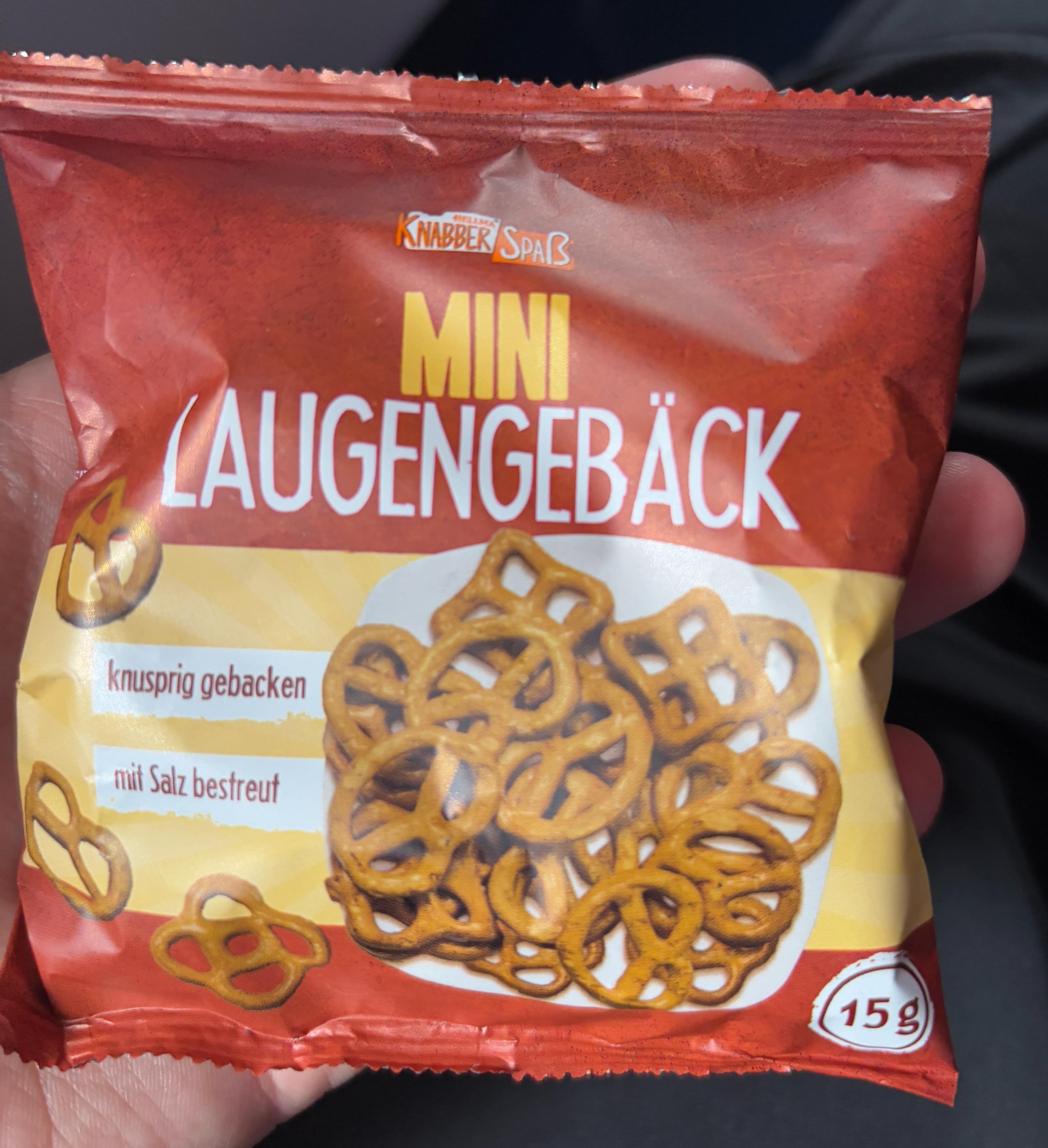
The only snack available on Condor premium economy between services, and only if you can get the attention of the crew.
It is common even in long-haul economy for crew to stock the galleys with water and basic snacks between services. Condor does not do this, and to charge for a bag of chips or the like is only acceptable on a low-cost carrier or short-haul economy service.
The small, bad, packaged meals and lack of snacks left me hungry after an eight-hour flight in Condor premium economy.
The pre-landing snack was served starting exactly two hours before landing. It consisted of a fruit bowl (which was all apple and one lonely piece of mango), small pasta salad, cheese pizza, and packaged cookie. The pizza was the best part of the food service, and even that I would not have been surprised to see as a pre-landing economy snack.
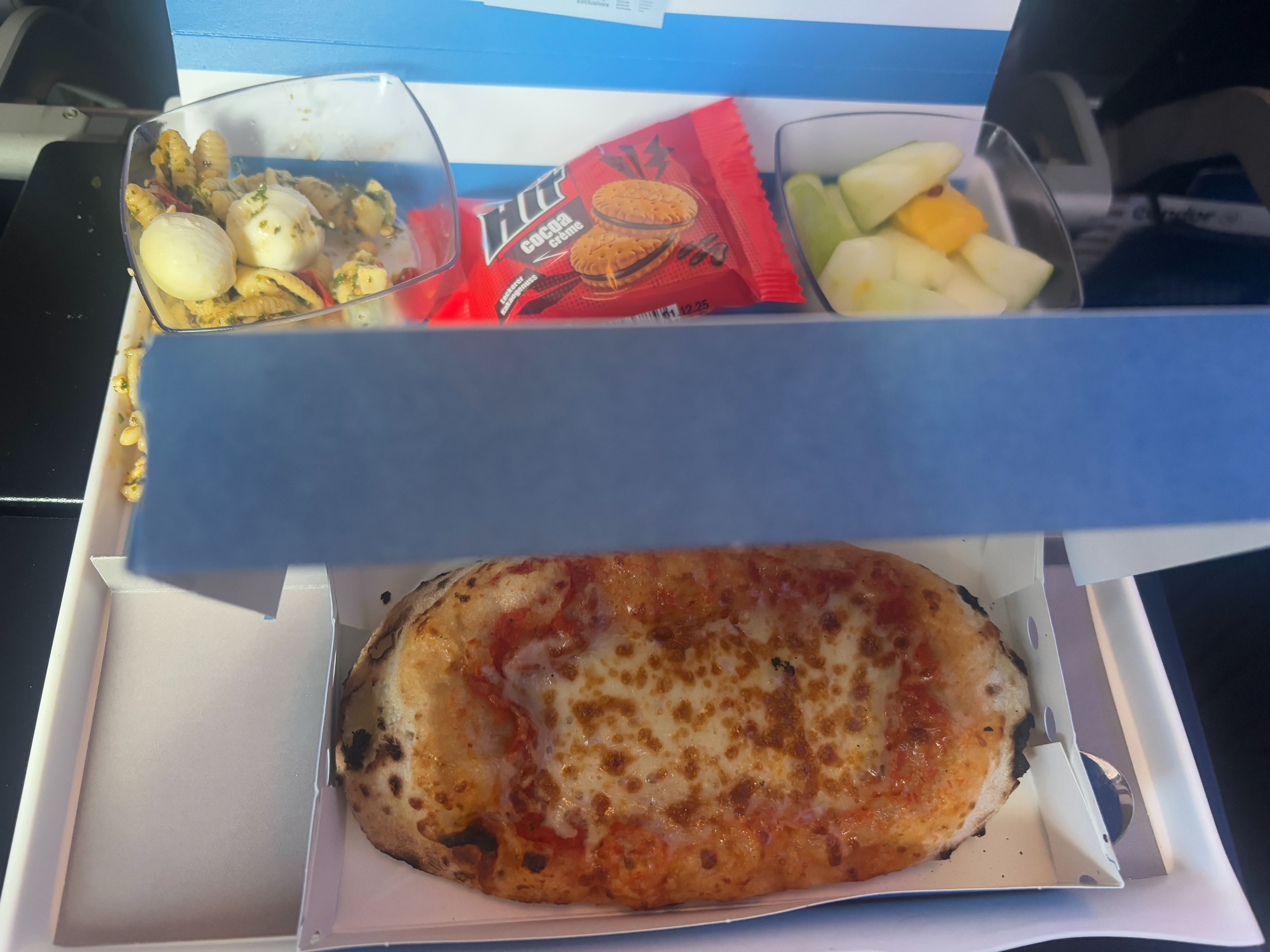
The pre-landing pizza was the only food served in Condor premium economy I considered good (the spilled pasta above was my fault).
Service was unfortunately below average. Crew just seemed to be going through the motions, and even then basic attention to detail was missing: not once did the crew clear trash aside from removing the two meal trays, and plastic cups from the final drink service two hours before landing were all either disposed of by passengers or left in the seatback pockets. Washrooms were not cleaned at all during the flight, and were in a poor state by the time we landed.
The one point in the crew’s favour was enforcing cabin-specific services: premium economy passengers who tried passing by the business class curtain were correctly turned back, and economy passengers trying to bring trash to the premium economy galley were also directed back (though in that case, it’s more a reflection of just how bad crews in both cabins were at removing waste).
Booking, Costs, and Points
I booked this one-way itinerary as a single ticket from Helsinki to Frankfurt with Finnair, and onto Toronto with Condor. This cost $779.99 CAD, and included a personal item, carry-on, and checked bag. Condor passengers are able to earn Alaska miles: premium economy tickets booked through Condor will earn 100% of the actual miles flown, or 150% if booked on Alaska’s own website (not an option for my itinerary).
The fare difference between regular and premium economy was only $120 when I booked, which is about what I would expect to pay to select an extra legroom seat on a long-haul flight. The full cost was cheaper than any other option I could put together a month in advance in economy class, and was less even than flying from Helsinki to London with Ryanair and onwards to Toronto with Air Transat, both low-cost carriers.
Snagging a seat in Condor premium economy for less than the cost of economy on a low-cost carrier is good value, and reflective of the standard of service on offer.
Even a day before departure, Condor was selling the direct FRA-YYZ flight, in premium economy, for less than $750 CAD (just under €500).
This is by far the best reason to choose Condor: they regularly make available cheap fares for convenient itineraries. On this occasion I needed to get back to Canada after flying over on an Aeroplan redemption, and one-way Europe to North America flights can often be more expensive than roundtrip tickets. Condor fit the bill, and while I would never pay the higher fares they charge in peak season (this exact same route is going for twice the cost on a Sunday in June, about four months away from when I’m writing this), they can be a very competitive, reasonably comfortable option.
Final Thoughts
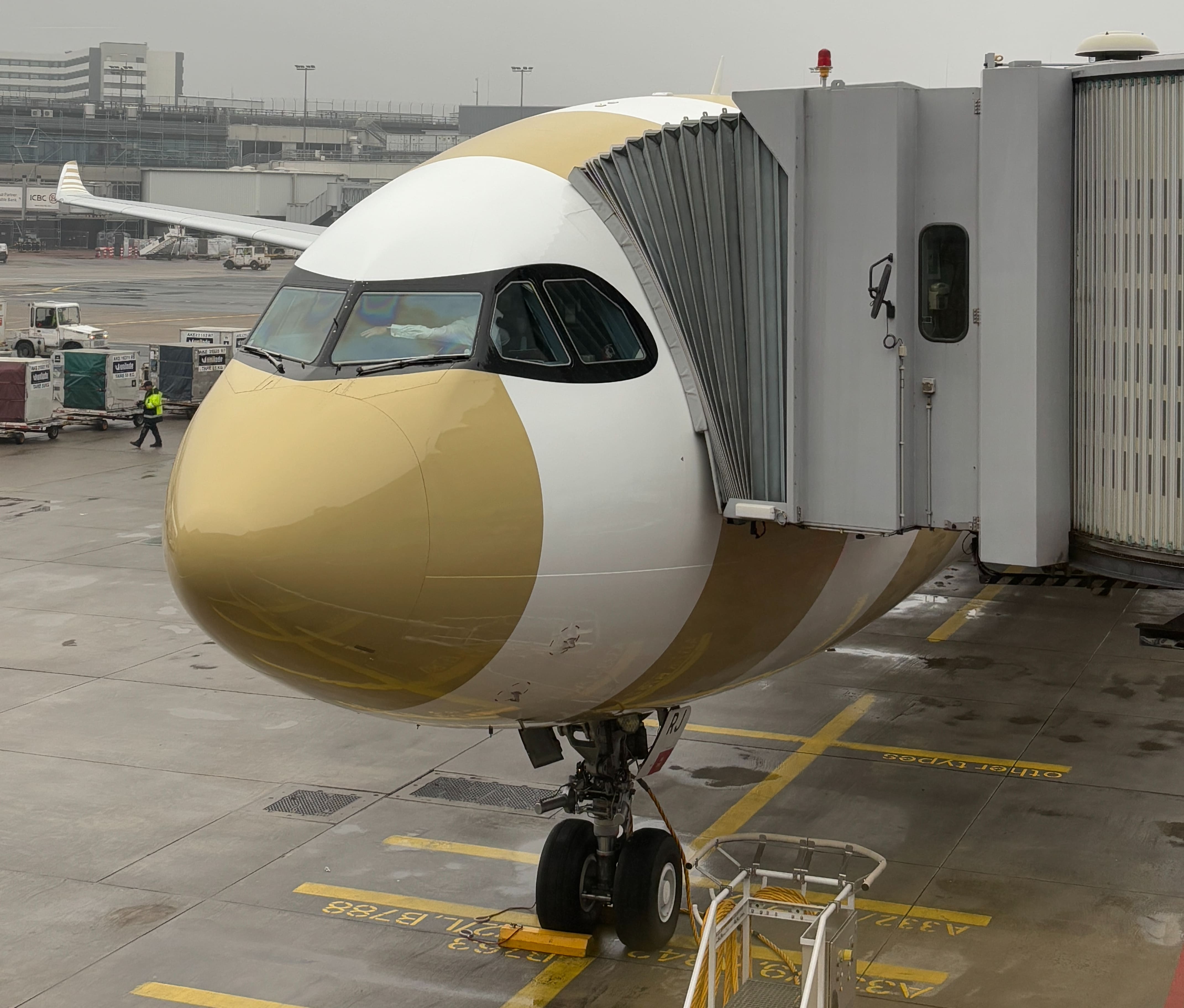
Even though it's not up to scratch as a premium economy product, for a cheap price I would fly Condor again...expecting economy service with a bit more legroom.
We touched down one minute early, having made up our departure delay in the air taking eight hours, 19 minutes to cover the 3,953 miles between Frankfurt and Toronto at 39,000 and 41,000 feet.
Condor premium class is best seen as a good economy product. It isn’t in the same league even as the premium economy offered by Lufthansa Group carriers, which feature entirely different and much better seats than regular economy. I’d say the best comparison is with an exit row seat on an average airline: if you can get from, say, Munich to New York with Condor in premium economy for the same or less than flying in regular economy with an extra legroom seat on British Airways, or United, or any other mediocre airline, you’ll have a marginally better experience on Condor.
It’s not a product to look forward to, or one I’d go out of my way to fly. But for daytime flights when the price and itinerary are right, I’d book Condor premium economy again.